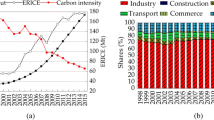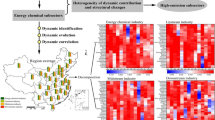Abstract
There has been growing interest among researchers in factors influencing carbon emissions of energy-intensive industries in China due to the important roles they play. Such studies mainly focused on evaluating carbon emissions and identifying the contributing factors separately for each energy-intensive industry. Regarding energy-intensive industries as a whole and investigating the contribution of each industry to changes in carbon intensity have not yet been sufficiently addressed and quantified. In order to deeply understand this issue, this study employed the LMDI decomposition analysis to study driving forces (e.g., emission coefficient, energy intensity, and industrial structure) of carbon intensity of energy-intensive industries. Then, attribution analysis was further used to study the contribution of each energy-intensive industry to the percent change in carbon intensity through each impact factor. The results showed that the carbon intensity of energy-intensive industries dropped by 31.83% from 1996 to 2014. The energy intensity effect was largely responsible for this decrease, of which, five industries were the contributors except for the fuel-processing industry. The industrial structure effect also contributed to the decrease, and non-metallic industry and fuel-processing industry played important roles. However, the emission coefficient effect showed a slight impact on increasing carbon intensity, which principally due to chemical industry and power generation industry. The findings suggested that the adaptability and sensitivity of different energy-intensive industries to the implemented policies were various. Based on the results, differentiated and feasible policies related to energy intensity, industrial structure, and energy structure for energy-intensive industries were provided to further mitigate carbon intensity.






Similar content being viewed by others
Notes
The scope of energy-intensive industries in China is confirmed in “2010 National Economic and Social Development Statistics Bulletin of China”.
The policy was aimed at six energy-intensive sectors, and enterprises attributed to these sectors were grouped into four groups based on levels of technology and energy efficiency: encouraged, permitted, restricted, and eliminated. For enterprises in the “encouraged” and “permitted” groups, electricity prices were consistent with the industrial electricity price in their regions, of which the price was between 0.64 and 0.73 Yuan/kWh from 2006 to 2010. Enterprises in the “restricted” and “eliminated” groups were required to pay surcharges of 0.02 Yuan and 0.05 Yuan per kWh, respectively.
Data source: China Industrial Information Network from National Bureau of statistics.
References
Andrés L, Padilla E (2014) Energy intensity in road freight transport of heavy goods vehicles in Spain. Energy Policy 85:309–321
Ang BW (2004) Decomposition analysis for policy making in energy: which is the preferred method? Energy Policy 32:1131–1139
Ang BW (2006) Monitoring changes in economy-wide energy efficiency: from energy—GDP ratio to composite efficiency index. Energy Policy 34:574–582
Ang BW (2015) LMDI decomposition approach: a guide for implementation. Energy Policy 86:233–238
Ang BW, Zhang FQ (2000) A survey of index decomposition analysis in energy and environmental studies. Energy 25:1149–1176
Chen WY, Yin X, Ma D (2014) A bottom-up analysis of China’s iron and steel industrial energy consumption and CO2 emissions. Appl Energy 136:1174–1183
Choi KH, Ang BW (2012) Attribution of changes in Divisia real energy intensity index—an extension to index decomposition analysis. Energy Econ 34(1):171–176
Choi KH, Oh W (2014) Extended Divisia index decomposition of changes in energy intensity: a case of Korean manufacturing industry. Energy Policy 65(2):275–283
Fernández González P (2015) Exploring energy efficiency in several European countries. An attribution analysis of the Divisia structural change index. Appl Energy 137:364–374
Fernández González P, Landajo M, Presno MJ (2013) The Divisia real energy intensity indices: evolution and attribution of percent changes in 20 European countries from 1995 to 2010. Energy 58:340–349
Fernández González P, Presno MJ, Landajo M (2015) Regional and sectoral attribution to percentage changes in the European Divisia carbonization index. Renew Sustain Energy Rev 52:1437–1452
González D, Martínez M (2012) Changes in CO2 emission intensities in the Mexican industry. Energy Policy 51(4):149–163
IEA (2012) CO2 emissions from fuel combustion highlights. Int Energy Agency, Paris
Intergovernmental Panel on Climate Change (IPCC) (2007) IPCC fourth assessment report. http://www.ipcc.ch/publications_and_data/publications_and_data_reports.htm; [accessed 07.02.10]
Intergovernmental Panel on Climate Change (IPCC). Mitigation of Climate Change (2014) Working Group III Contribution to the Fifth Assessment Report of IPCC fifth assessment report, Cambridge University Press, UK
Kahrl F, Roland-Holst D, Zilberman D (2013) Past as prologue? Understanding energy use in post-2002 China. Energy Econ 36:759–771
Kang JD, Zhao T, Liu N, Xu XS (2014) A multi-sectoral decomposition analysis of city-level greenhouse gas emissions: case study of Tianjin, China. Energy 68(4):562–571
Kim YG, Yoo JY, Oh W (2015) Driving forces of rapid CO2 emissions growth: a case of Korea. Energy Policy 82:144–155
Li H, Shi JF (2014) Energy efficiency analysis on Chinese industrial sectors: an improved Super-SBM model with undesirable outputs. J Clean Prod 65(4):97–107
Li L, Wang JJ, Tan ZF, Ge XQ, Zhang J, Yun XZ (2014) Policies for eliminating low-efficiency production capacities and improving energy efficiency of energy-intensive industries in China. Renew Sustain Energy Rev 39(6):312–326
Lin B, Liu J (2011) Principles, effects and problems of differential power pricing policy for energy intensive industries in China. Fuel Energy Abstr 36(36):111–118
Lin B, Long H (2014) How to promote energy conservation in China’s chemical industry. Energy Policy 73(C):93–102
Lin B, Long H (2015) A stochastic frontier analysis of energy efficiency of China’s chemical industry. J Clean Prod 87:235–244
Lin B, Long H (2016) Emissions reduction in China’s chemical industry—based on LMDI. Renew Sustain Energy Rev 53:1348–1355
Lin B, Ouyang X (2014) Analysis of energy-related CO2, (carbon dioxide) emissions and reduction potential in the Chinese non-metallic mineral products industry. Energy 68(8):688–697
Lin B, Wang X (2015) Carbon emissions from energy intensive industry in China: evidence from the iron & steel industry. Renew Sustain Energy Rev 47:746–754
Lin B, Zhao H (2015) Energy efficiency and conservation in China’s chemical fiber industry. J Clean Prod 103:345–352
Liu N, Ma ZJ, Kang JD (2015) Changes in carbon intensity in China’s industrial sector: decomposition and attribution analysis. Energy Policy 87:28–38
Long X, Zhao X, Cheng F (2015) The comparison analysis of total factor productivity and eco-efficiency in China’s cement manufactures. Energy Policy 81:61–66
Mahony TO, Dufour J (2015) Tracking development paths: monitoring driving forces and the impact of carbon-free energy sources in Spain. Environ Sci Policy 50:62–73
National Bureau of Statistics of China (NBSC) (1997–2008). China Statistics Yearbook (CSY). China Statistical Press, Beijing (in press)
National Bureau of Statistics of China (NBSC) (1997–2015a). China Energy Statistics Yearbook (CESY). China Statistical Press, Beijing
National Bureau of Statistics of China (NBSC) (2009–2015b). Growth rate of industrial added value in major industries. http://data.stats.gov.cn/easyquery.htm?cn=A01
Ren S, Hu Z (2012) Effects of decoupling of carbon dioxide emission by Chinese nonferrous metals industry. Energy Policy 43(2):407–414
Song M, Zhang J, Wang S (2015) Review of the network environmental efficiencies of listed petroleum enterprises in China. Renew Sustain Energy Rev 43:65–71
Wang YJ, William C (2010) The Chinese non-ferrous metals industry-energy use and CO2 emissions. Energy Policy 38(11):6475–6484
Wang J, Zhao T (2016) Regional energy-environmental performance and investment strategy for China’s nonferrous metals industry: a non-radial DEA based analysis. J Clean Prod. doi:10.1016/j.jclepro.2016.0
Wang Z, Zhang B, Yin J (2011) Determinants of the increased CO2 emission and adaption strategy in Chinese energy-intensive industry. Nat Hazards 62(1):17–30
Wang Y, Zhu Q, Geng Y (2013) Trajectory and driving factors for GHG emissions in the Chinese cement industry. J Clean Prod 53:252–260
Wang J, Zhao T, Xu XS, Zhang XH (2016) Exploring the changes of energy-related carbon intensity in China: an extended Divisia index decomposition. Natural Hazards 83(1):501–521
Wen ZG, Li HF (2014) Analysis of potential energy conservation and CO2 emissions reduction in China’s non-ferrous metals industry from a technology perspective. Int J Greenh Gas Control 28:45–56
Xu X, Zhao T, Liu N, Kang JD (2014) Changes of energy-related GHG emissions in China: an empirical analysis from sectoral perspective. Appl Energy 132(11):298–307
Yang LS, Lin BQ (2016) Carbon dioxide-emission in China’s power industry: evidence and policy implications. Renew Sustain Energy Rev 60:258–267
Yang M, Patiño-Echeverri D, Yang F, Williams E (2015) Industrial energy efficiency in China: achievements, challenges and opportunities. Energy Strategy Rev 6:20–29
Ye B, Jiang JJ, Li CS, Miao LX, Tang J (2017) Quantification and driving force analysis of provincial-level carbon emissions in China. Appl Energy 198:223–238
Yuan R, Zhao T (2016a) A combined input-output and sensitivity analysis of CO2 emissions in the high energy-consuming industries: a case study of China. Atmos Pollut Res 7(2):315–325
Yuan R, Zhao T (2016b) Changes in CO2 emissions from China’s energy-intensive industries: a subsystem input–output decomposition analysis. J Clean Prod 117:98–109
Zhang N, Choi Y (2013) Total-factor carbon emission performance of fossil fuel power plants in China: a metafrontier non-radial Malmquist index analysis. Energy Econ 40(2):549–559
Zhang B, Wang Z, Yin J, Su L (2012) CO2 emission reduction within Chinese iron & steel industry: practices, determinants and performance. J Clean Prod 33:167–178
Zhang N, Kong F, Choi Y, Zhou P (2014) The effect of size-control policy on unified energy and carbon efficiency for Chinese fossil fuel power plants. Energy policy 70(4):193–200
Zhao XL, Ma CB, Hong DY (2010) Why did China’s energy intensity increase during 1998–2006: decomposition and policy analysis. Energy Policy 38:1379–1388
Zhou GH, Chung W, Zhang YX (2014) Carbon dioxide emissions and energy efficiency analysis of China’s regional thermal electricity generation. J Clean Prod 21:1–12
Zhu B, Zhou WJ, Hu SY, Li Q, Griffy-Brown C, Jin Y (2010) CO2 emissions and reduction potential in China’s chemical industry. Energy 35(12):4663–4670
Acknowledgements
This research acknowledges the financial support from the Major Program of Social Science Foundation of Tianjin Municipal Education Commission (2016JWZD04), the Independent Innovation Foundation of Tianjin University (2017XSZ-0055), the Ministry of Education of Philosophy and Social Major Science Project (15JZD021), and the Ministry of Education of Humanities and Social Science Research Fund Plan (15YJA790091). The authors are grateful to the anonymous reviewers for their valuable suggestions and comments on the earlier draft of our paper.
Author information
Authors and Affiliations
Corresponding author
Rights and permissions
About this article
Cite this article
Wang, J., Zhao, T. & Zhang, X. Changes in carbon intensity of China’s energy-intensive industries: a combined decomposition and attribution analysis. Nat Hazards 88, 1655–1675 (2017). https://doi.org/10.1007/s11069-017-2938-8
Received:
Accepted:
Published:
Issue Date:
DOI: https://doi.org/10.1007/s11069-017-2938-8




